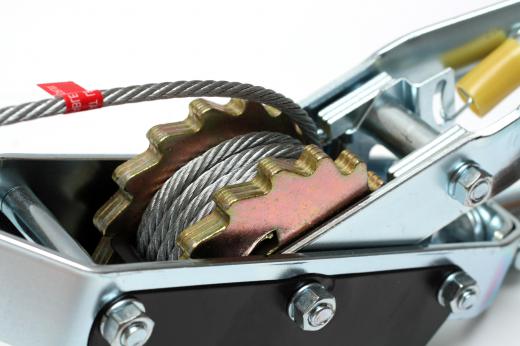Wrenches, screwdrivers, electrical crimpers and pipe cutters are common ratchet tools. A ratchet action tool allows an operator to keep the tool attached to a material while moving it. This eases the process of using the tool in tight areas where other tool styles will not fit and work correctly. Using, storing and maintaining ratchet tools correctly will keep the tool in proper working order. Improper use causes the ratchet action of the tool to function incorrectly and cause injury to the operator if the tool should slip or lock up during use.
Ratchet handle wrenches are a common sight in garages and construction sites. Held within the head of the wrench is a gear mechanism that allows the handle to turn while an attachment on the head remains attached to a fastener. Moisture entering the connecting point between the ratcheting head and the ratchet handle causes the internal components to rust. Regularly oiling the connecting points keeps the gears of this ratchet tool loose and in proper working order. A ratchet handle is not the style of ratchet tools that requires regular maintenance to keep the internal gears free of corrosion.

Chain-style cutters used on cast iron, terracotta and clay piping employ a ratchet action head to apply pressure to the cutting chain. Lubricating the point at which the cutting chain enters the ratcheting head will eliminate rust forming on the ratcheting gears. Unlike a ratchet handle wrench, the cutting chain is connecting directly to the ratchet head. This allows water to travel into the ratchet head as the chain pulls around the pipe. Constant lubrication of the cutting chain ensures moisture does not travel into the casing surrounding the ratcheting gears.

Sealed ratchet tools do not require constant lubrication to ensure proper working order but are more delicate than their heavy-duty counter parts. Ratchet action screwdrivers have a sealed area where the tool holder enters the screwdriver body and ratchet action electrical crimpers keep the area around the ratchet action jaws sealed with a rubber gasket. The plastics and rubbers used to seal this style of ratchet tools eliminates the need for lubrication but makes the tools more susceptible to damage during use or when improperly stored. Keeping each tool in a cushioned tool box and taking care not to drop or throw the tools during use will keep the plastic components of the tools from cracking or coming loose from the tool body.
